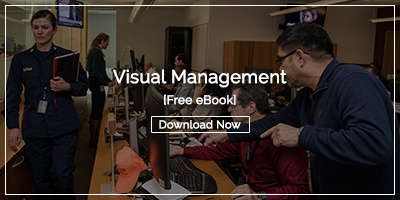 People start, work on, and complete projects in organizations all of the time. Some projects are carefully planned and managed, while others happen more haphazardly out of urgency or necessity. In most cases, the more effort you put into planning and controlling your project, the more likely you are to achieve success. After working with customers for many years on everything from Lean implementation to construction project management, we've noticed several elements of project success.
People start, work on, and complete projects in organizations all of the time. Some projects are carefully planned and managed, while others happen more haphazardly out of urgency or necessity. In most cases, the more effort you put into planning and controlling your project, the more likely you are to achieve success. After working with customers for many years on everything from Lean implementation to construction project management, we've noticed several elements of project success.
Project Goals and Requirements
One crucial element that is often overlooked, especially when a project is started to fix a severe and time-sensitive problem, is the project requirement document, sometimes called the project charter. A helpful project charter includes a description of the problem to be addressed. It also includes the list of goals and the definition of project success.
The project requirements document will vary based on the type of project, but it is most helpful if it is complete and is all the relevant stakeholders agree on its terms. It is also often useful to spell out what is outside of the project's scope to make sure that the stated goals are achieved without going on semi-related tangents.
Executive Support
Almost all projects involve some level of investment; if nothing else, they require the acquisition of workers' time. Therefore, it is essential to have executive support for any substantial project. The executive team can commit any financial, material, or human resources necessary for the project. They can also serve to eliminate any roadblocks or unexpected challenges.
It is usually smart to develop the project requirements first and then present them to the executive sponsor for review and approval. A well throughout charter goes a long way in securing the management team support required.
The Project Team
The next step is to assemble the team necessary to complete the project. Keep in mind that the human resources required may go beyond just the people who will work on the project. It is usually helpful to designate a project leader or facilitator. This person will document the team's work, communicate when needed, and measure the difference between the current state and the post-project results. In most cases, process operators will also be part of the project team since they will have valuable insight into the problem and its potential causes. Sometimes subject matter experts can help guide decisions during the project.
Project Plan
The project plan is the next objective once the charter and team members are in place. The plan should outline the critical path or the steps that must be accomplished in succession to reach the objective. It should also include the project delivery time and any specific associated milestone dates. Finally, it should consist of a list of tasks with owners and deadlines to the extent possible. The project plan may change as work gets underway, but it is still essential to start with a roadmap to guide the effort.
An essential element of the project plan is risk management. No project worthy of effort is without risk. Therefore, project managers must be good at making a pre-project assessment of the potential risks. Those risks are classified and prioritized based on the potential that they will occur and the likely impact. The project plan should include mitigation steps and an owner for all high-likelihood and high-impact risks.
Project Management Techniques and Skills
One type of project resource that is often overlooked is the management skills and problem-solving techniques that team members bring into the project. The good news about investing in this project resource is that it can be leveraged repeatedly throughout many projects. Several examples of project management techniques that can be helpful are:
The 5 Whys: The 5 whys is a problem-solving technique that helps team members get to the root cause of an issue. Team members simply state the problem and then continue to ask "why" until the heart of the issue is revealed. This usually takes about five iterations. The technique ensures that the project addresses the core issue and not a symptom. It also helps avoid blaming people when a process or equipment problem is at fault.
PDSA: Plan, Do, Study, Adjust is a structured improvement cycle borrowed from the Lean business methodology. Each project begins with a plan and a hypothesis about what will solve the issue. The team then implements an experiment and studies the results. They then make any necessary adjustments to achieve the stated goals.
Kanban: Kanban is a visual management technique for managing work in progress and eliminating any bottlenecks or idleness. Each state of work is listed as a column, and each element of work-in-progress is represented by a card that moves from one state to the next. The simplest example includes columns for To Do, Doing, and Done, but this varies based on the type of project.
Fishbone Diagrams: A fishbone diagram structures the potential causes of a problem in the categories of materials, people, environment, methods, machines, and measurements.
Value Stream Mapping: Value stream maps visualize the flow of value to the customer and can help identify wasteful operations.
Related: Learn more about project management skills in the Project Management Institute's flagship publication, A Guide to the Project Management Body of Knowledge (PMBOK® Guide).
Budget and Materials
Resource allocation is perhaps the most evident element of project management. The project charter and plan will help determine what raw materials, equipment, space, and other required resources. Skilled project managers expect some surprises and build-in buffers to ensure the project is completed at or below the expected budget.
Supportive Technology
These days, most organizations use project management software to ensure each project's success and create a repository of tribal knowledge. Modern solutions are hosted in the cloud and available 24x7 from anywhere. Often mobile apps make project work even more convenient. While it is possible to manage a project using spreadsheets and email, this is not ideal as the approach is error-prone and difficult to operate effectively. Instead, look for software with:
Active Workflow: Automated alerts and notifications help keep everyone on target and ensure that project leaders know when work is stalled.
Visual Management: If your team will use some of the project management techniques we mentioned above, like kanban, fishbone diagrams, and values team mapping, make sure the project management platform includes support for these visual management tools.
Robust Search: Once your team starts documenting project work in a central repository, its search capabilities will ensure that team members learn from what has been done in the past. Every project will build on the lessons from the last.
Customizable Dashboards: Each person will have different visual management needs based on their role in the organization and in each particular project. Customizable dashboards allow everyone to process the data most critical to them instantly.
Impact Reporting: You've carefully defined success for your project, so make sure the technology you choose can help you report on the impact your changes make in the near and long term.
Success requires careful deliberation, whether your team has dedicated project managers or takes a more ad-hoc approach to projects with various team members pitching in. With the right technology, skills, and plan in place, you are sure to accomplish more in less time.



Add a Comment